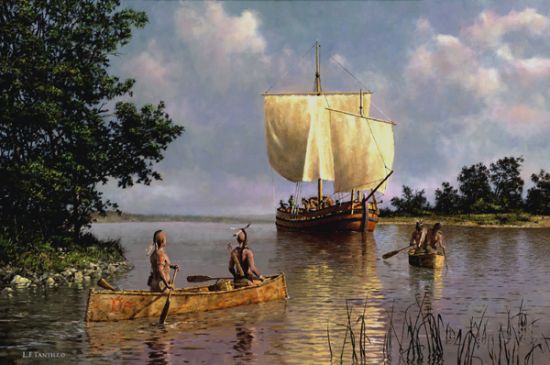
Len Tantillo, Curiosity of the Magua - Native Americans in Elm-bark canoes.
Some of the canoes that are mentioned in Dutch and English records are canoes made of bark, unfortunately “what kind” of bark is not usually mentioned but some sources that have survived have named elm bark (commonly used to cover homes) and of course there are historical and contemporary examples of birch bark canoes. In southern New Netherlands, birch trees would be scarce and elm bark would have been more common for a “disposable / temporary” canoe as opposed to the dugout which was very long lasting but heavy. Bark canoes were lightweight, and could be carried overland if necessary to get from one river to another.
However, we are fortunate that primary sources from New England some some from New Netherlands shed light on these bark canoes. (1) “When the Indians travel by water for trading purposes they always come down this river [Maquas-Kil – Mohawk River] in watercraft that they know how to make of tree bark.”
(2) Their boats, whereof we brought one to Bristol, were in proportion like a wherry of the River Thames, seventeen foot long and four foot broad, and made of the bark of a birch tree, far exceeding in bigness those of England. It was sewed together with strong and tough osiers or twigs [likely misidentifying split spruce, hemlock, white pine roots], and the seams covered over with rosin or turpentine little inferior in sweetness to frankincense, as we made trial by burning a little thereof on the coals at sundry times after our coming home. It was also open like a wherry and sharp at both ends, saving that the beak was a little bending roundly upward. And though it carried nine men standing upright, yet it weighed not at the most above sixty pounds in weight.”
Unfortunately not much is known about how these elm bark canoes were made in the 17th century; only really that they existed and were used; but it is likely that their construction would have been similar to the way a birch bark canoe is constructed.
Drew Shuptar-Rayvis
- A Description of New Netherland , Adriaen Van Der Donck (1647) , paragraph 1, pg 13, of the North River
- Indian New England 1524-1674, Ronald Dale Karr, pg 94, paragraph 1 , Martin Pring (1603) 64-65, Plymouth Massachusetts

